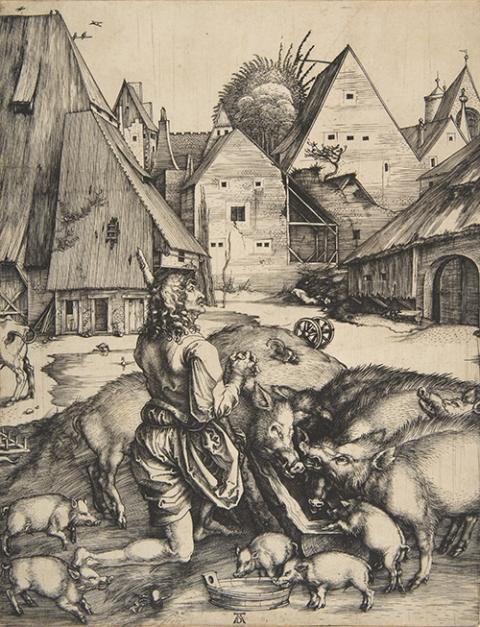
Detail from "The Prodigal Son Among the Pigs" (1496) by Albrecht Dürer (Metropolitan Museum of Art)
The prodigal son kneels among pigs, surrounded by buildings in a wretched state of disrepair; their dilapidation mirrors the son's physical and spiritual destitution. The setting is the village of Himpfelshof, just west of Nuremberg, home to Albrecht Dürer, the creator of this magnificent engraving.
Dürer, born in 1471, became one of the most famous Renaissance artists in Northern Europe. He is best known for his woodcuts and engravings such as this one, "The Prodigal Son Among the Pigs," stunning in their power, imagery and layers of meaning.
In this striking piece, the urgency of the pigs' scramble for food matches the urgency of the prodigal's physical and spiritual hunger. The viewer's gaze is immediately drawn to the prodigal, who kneels on one knee with clasped hands and eyes raised to heaven.
The pose portrays the moment when the prodigal "came to himself" (Luke 15:17). The prodigal regrets his earlier decisions to demand his inheritance, leave home, and squander "his property in dissolute living" (Luke 15:13). Here, Dürer captures the prodigal's utter destitution and the very moment he decides to go home, ask his father's forgiveness and request to be treated as a servant.
Most interpreters understand the ambiguous "came to himself" as true repentance, even though the parable itself leaves open the possibility that it just means "came to his senses." In the context of Luke 15 — the last of the "lost and found" parables (lost sheep, lost coin and lost son) — however, the story reads as one of repentance and the resulting celebration (Luke 15:1-2, 6-7, 9-10, 24, 32). That is how Dürer understands it.
Advertisement
Dürer's masterpiece clearly portrays the prodigal as penitent, whose pose shows his remorse and repentance. The prodigal also bears a striking resemblance to Dürer himself, which may be the first example of a visual artist identifying with the prodigal, and perhaps even portrays Dürer's own spiritual journey.
Insights about the parable from the great theologian Howard Thurman can enhance our appreciation of Dürer's image and the spiritual journey it can evoke.
Like the engraving, Thurman believes that the famine in the land reflects not only the prodigal's physical hunger but his internal spiritual famine: "The famine that the boy experienced in the far country, he was already experiencing in his own heart. It's very simple."
The desolation of the prodigal son in Dürer's engraving depicts his isolation, and for Thurman, the parable illustrates how human beings can move from such isolation to an assurance of community.
Thurman's insights lead us to go beyond merely identifying with the prodigal son — or, for some, the elder brother. They lead us toward identifying with the father, even if he symbolizes God in the parable, and emulating his compassion.
When people "come to themselves," it is in response to "a seeking and beseeching God." Thurman muses about how the prodigal's desperation, the degradation of his spirit, led to "a stirring down at the bottom of his being" that said, "You are lost. You are out of contact with your family. You are out of community. Why don't you go home?"
Thurman thus argues for a deeper spiritual meaning of when the son "came to himself" and envisions it as an exemplar for one's spiritual journey, his mysticism-guided vision that human beings can discover God within themselves and realize who they really are.
For Thurman, it is in this context that the prodigal's experience must be understood:
When [the prodigal] came to himself, he came to his father. That when I ... come to the very center, the very core of myself, then I come face to face with God. That God is, God is within me. That he is the very point of my being and existence. ... That there is that of man which is God. Not a reflection of God. Not some staggering accent of God, but that which is God.
Thurman discusses the presence of the divine most famously in his ambiguous characterization of the "sound of the genuine" in every human being.
The "genuine" is at work in God's creation, and human beings thus become "out of touch" when they do not listen to the sound of the genuine within them. Like the prodigal, without that awareness, we "stumble in the darkness."

"The Prodigal Son Among the Pigs" (1496) by Albrecht Dürer (Metropolitan Museum of Art)
Not only is there something inside every human being that waits and listens for the sound of the genuine within themselves, but there is something inside every human being that waits and listens for the sound of the genuine in other human beings. Out of that listening and responding to the sound of the genuine in ourselves and others comes true community.
Thurman also reflects on how human beings can identify with and learn from the prodigal and then actively work to create community. Thurman's insights into Jesus' teachings lead us to go beyond merely identifying with the prodigal son — or, for some, the elder brother. They lead us toward identifying with the father, even if he symbolizes God in the parable, and emulating his compassion.
Thurman points to Luke 6:35-36, where Jesus says that if people want to be children of God they must "be merciful, just as your Father is merciful."
He deduces that God expects human beings to be like God: "What an amazing concept! The creative mind and spirit of God dares to assume that it is within the range of possibility for human life that men shall become and shall behave and perform like God. Here is at once the most radical interpretation of the meaning of dignity and human worth."
Both brothers, the parable argues, should "come to themselves," end their self-estrangement, and be restored to full community. What the parable really wants from its readers, however, is to be "filled with compassion" like the father for his son, the same compassion that Jesus shows a widow whose only son had died (Luke 7:11-17) and the good Samaritan gives a "half-dead" man (Luke 10:30-33).
In the Prodigal Son parable, then, the father models the compassion that Jesus shows for others, that Jesus proclaims God embodies, and that Jesus commands his followers to have for all human beings.






